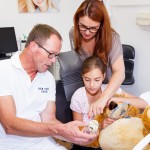
Prominent lower front teeth (reverse bite; under bite; Class III malocclusion) are more common in oriental (15%) and black races (10%) and relatively uncommon in Caucasian (4%) populations. Several orthodontic approaches have been suggested to correct this and the aim of this Cochrane review was to assess the effects of orthodontic treatment for prominent lower front teeth in children and adolescents.
The Cochrane Oral Health Group’s Trials Register, The Cochrane Central Register of Controlled Trials (CENTRAL), Medline and Embase databases were searched. Randomised controlled trials (RCTs) in children and adolescents aged 16 years or under receiving any type of orthodontic treatment to correct Class III malocclusions were included. Screening of references, identification of included and excluded studies, data extraction and assessment of the risk of bias of the included studies was performed independently and in duplicate by two reviewers. Meta-analysis was only undertaken when studies of similar comparisons reported comparable outcome measures.
- 7 RCTs with a total of 339 participants were included in this review.
- One study was assessed as at low risk of bias, 3 at high risk, and in 3 studies the risk of bias was unclear.
- 4 studies reported on the use of a facemask, 2 on the chin cup, one on the tandem traction bow appliance, and one on mandibular headgear. One study reported on both the chin cup and mandibular headgear appliances.
- One study (n = 73, low quality evidence), comparing a facemask to no treatment, reported a mean difference (MD) in overjet of 4.10 mm (95% confidence interval (CI) 3.04 to 5.16; P value < 0.0001) favouring the facemask treatment. Two studies comparing facemasks to untreated control did not report the outcome of overjet. Three studies (n = 155, low quality evidence) reported ANB (an angular measurement relating the positions of the top and bottom jaws) differences immediately after treatment with a facemask when compared to an untreated control. The pooled data showed a statistically significant MD in ANB in favour of the facemask of 3.93 ° (95% CI 3.46 to 4.39; P value < 0.0001). There was significant heterogeneity between these studies (I2 = 82%). This is likely to have been caused by the different populations studied and the different ages at the time of treatment.
- One study (n = 73, low quality evidence) reported outcomes of the use of the facemask compared to an untreated control at three years follow-up. This study showed that improvements in overjet and ANB were still present three years post-treatment. In this study, adverse effects were reported but due to the low prevalence of temporomandibular (TMJ) signs and symptoms no analysis was undertaken.
- Two studies (n = 90, low quality evidence) compared the chin cup with an untreated control. Both studies found a statistically significant improvement in ANB, and one study also found an improvement in the Wits appraisal. Data from these two studies were not suitable for pooling.
- A single study of the tandem traction bow appliance compared to untreated control (n = 30, very low quality evidence) showed a statistically significant difference in both overjet and ANB favouring the intervention group.
- The remaining two studies did not report the primary outcome of this review.
The authors concluded
There is some evidence that the use of a facemask to correct prominent lower front teeth in children is effective when compared to no treatment on a short-term basis. However, in view of the general poor quality of the included studies, these results should be viewed with caution. Further randomised controlled trials with long follow-up are required.
Links
Watkinson S, Harrison JE, Furness S, Worthington HV. Orthodontic treatment for prominent lower front teeth (Class III malocclusion) in children. Cochrane Database of Systematic Reviews 2013, Issue 9. Art. No.: CD003451. DOI: 10.1002/14651858.CD003451.pub2.

“@TheDentalElf: MT Some evid. for class 3 protraction http://t.co/Sng1LTDjwM” I optimistic, but I am an orthodontist! http://t.co/rOJ1aOynZa
[…] Dental Elf -18th Oct-2013 – Some evidence to support use of facemask appliance for class III m… […]